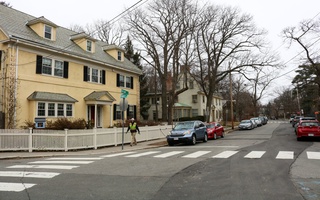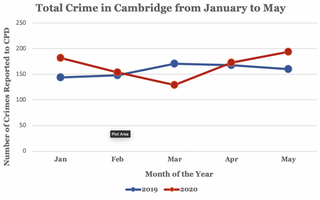{shortcode-b9ac67bd7893994a1ef02a31a414cceb479ad085}
The City of Cambridge experienced an 8 percent increase in serious crimes last year compared to 2019, according to a report published by the city Friday.
The serious crime hike can largely be traced to a 10 percent increase in property crimes, Cambridge Police Department spokesperson Jeremy C. Warnick wrote in a Wednesday night email. According to the FBI, property crimes include arson, burglary, larceny theft, and motor vehicle theft.
“Much of this property crime increase can be attributed to pandemic-related rises in thefts from motor vehicles and thefts of packages and bicycles,” Warnick wrote.
Serious crime is broken down into two categories: violent crime and property crime.
With social distancing measures and economic shutdowns in place, Cambridge saw 286 fewer violent crimes in 2020 than in 2019, corresponding to a two percent decrease in crimes such as aggravated assault, forcible rape, murder, and robbery.
CPD’s BridgeStat from December 2020 — a program used to disseminate monthly updates about crime in Cambridge — reports one homicide and 27 incidents of rape in 2020, equating to a zero percent change on both crimes from 2019. On April 23, 2020, a Massachusetts man was charged in the homicide of 33-year old Danilo Perez, a homeless man stabbed to death in Central Square.
Other violent crimes — such as street robbery and aggravated assault — decreased by 18 and 1 percent, respectively, according to BridgeStat.
However, commercial robberies increased by 27 percent — partially due to a string of armed bank robberies in late 2020. In January 2021, a Boston man was arrested in connection with one of these robberies. An investigation into the other bank robberies remains ongoing, according to a February email from Warnick.
In 2019, Cambridge reported the lowest number of serious crimes since 1968, at 2,257 violent and property crimes. Since 2010, crime has decreased every year with the exception of 2018 and, now, 2020.
Warnick wrote that CPD’s approach to fighting crimes is “data-centric,” explaining that the department deploys resources to certain areas at particular times where crimes occur the most often statistically.
—Staff writer Raquel Coronell Uribe can be reached at raquel.coronelluribe@thecrimson.com. Follow her on Twitter @raquelco15.

















